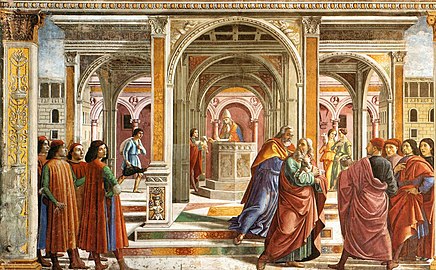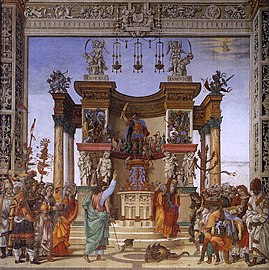Santa Maria Novella
The Basilica of Santa Maria Novella is a Gothic church and monastery complex in Florence . It is located in the northwest of the old town, on the Piazza Santa Maria Novella, opposite the train station named after it .
history
The basilica was built in place of the Dominican prayer rooms of Santa Maria delle Vigne from the 10th century . Construction began in the middle of the 13th century and lasted until the middle of the 14th century . The church was given the title Basilica minor in 1919 by Pope Benedict XV.
The design comes from two Dominicans , Fra Sisto da Firenze and Fra Ristoro da Campi . On behalf of the Rucellai family, Leon Battista Alberti designed the dark green and white marble facade of the church (1456–1470). Giorgio Vasari was the architect when the church was first remodeled, removing the original rood screen and gallery. The second renovation was planned by Enrico Romoli and carried out between 1858 and 1860.
The use of strict geometric shapes typical of the Renaissance can be seen in Alberti's facade, with a strong emphasis on the flat wall. Rectangles, squares, circles and round arches determine the design, as was the case with Brunelleschi's Pazzi Chapel 25 years earlier (motif of tetrastylos , high attic , volutes on both sides as geometric decorative shapes, incrustations made from various types of marble).
Alberti solved the problem of the balance between the horizontal and the vertical, and he also succeeded in creating a harmonious connection between the different storeys of the facade by adding two volutes, which are derived from the old Gothic buttresses, but through this strict and at the same time decorative geometry introduced a new form into the architecture of the Renaissance.
Inside you can see that it is actually a Gothic building, but in the typical Italian version. On the inside is a fresco by Sandro Botticelli's Nativity , under which there was once his painting The Adoration of the Magi , which is now on display in the Uffizi .
In the central nave there are pointed arches and a ribbed vault, but the side aisles are separated from the main nave by round arches, which are again so high and wide that they largely give the impression of a single room. A special feature of the Tuscan and Umbrian architecture is the ornamentation of arches and entire walls with alternating layers of color. Here only the arches and ribs are highlighted in color in this way, in Siena and Orvieto there are entire walls.
The interior is built as a Latin cross in three naves. The central nave is 100 meters long. In the left aisle you will find the fresco The Holy Trinity by Tommaso Masaccio after approx. 50 meters . The fresco shows perspective early in the history of painting .
Among the chapels are the “Capella della Pura”, the Rucellai Chapel, the Bardi Chapel, the Filippo Strozzi Chapel and the Gondi Chapel .
Cappella Tornabuoni
Domenico Ghirlandaio and his workshop created the frescoes in this main chapel between 1486 and 1490 on behalf of the banker Giovanni Tornabuoni . They cover an area of 400 m² and show scenes from the life of the Virgin Mary (including the birth of Mary ) and John the Baptist . In the 1960s, restorers coated them with a synthetic resin varnish in an attempt to save them from deterioration. But the colors became sulfuric acid compounds, and the top layer of the painting peeled off the wall. Experts from the state restoration studio Le pietre dure in Florence first had to consolidate the lime paint film before they could remove the varnish. After six years, the rescue was successful in 1991.
Artists involved in the construction
The church building shown is similar to the Florentine Cathedral . However, it is neither the building as planned by Arnolfo di Cambio, nor the one actually executed. It is likely to be a foreboding vision of the painter showing the completion of the cathedral. The painter was a member of several cathedral building commissions and was therefore familiar with the subject.
- Baccio D'Agnolo - wood carvings
- Agnolo Bronzino - the miracle of Jesus
- Giotto di Bondone - Crucifix (ca.1280)
- Tino di Camaino - Bust of St. Antoninus ( terracotta ); the tomb of the Bishop of Fiesole
- Nardo di Cione - Frescoes from the Last Judgment
- Duccio - Rucellai Madonna
- Lorenzo Ghiberti - Gravestone for Leonardo Dati (1423)
- Domenico Ghirlandaio - Frescoes in the Tornabuoni Chapel (late 15th century)
- Filippino Lippi - Frescoes in the Filippo Strozzi Chapel (1487–1502)
- Benedetto da Maiano - The Tomb of Filippo Strozzi (1491)
- Masaccio - the Trinity (1426-27)
- Nino Pisano - Madonna and Child
- Bernardo Rossellino - Tomb of Beata Villana (1451)
- Paolo Uccello - Frescoes in the monastery
- Giorgio Vasari - Madonna in the Rose Garden (1568)
- Frescoes by Domenico Ghirlandaio in the Tornabuoni Chapel
- Frescoes by Filippino Lippi in the Filippo Strozzi Chapel
organ
The organ goes back to an instrument from 1532, which has been expanded and reorganized over time. It is located in an organ case from the 15th century. The organ has 19 stops on two manuals and a pedal .
|
|
|
||||||||||||||||||||||||||||||||||||||||||||||||||||||||||||||||||
The Spanish Chapel
Santa Maria Novella is a monastery complex and, in addition to the church, has two cloisters and various monastery buildings. One of the most beautiful rooms in the complex is the chapter house . It is called the “Spanish Chapel”, which lies between the church and the outer cloister. It was built in the middle of the 14th century. The frescoes in the large room are by the otherwise little-known painter Andrea di Bonaiuto from around 1365 and have the allegory of the church as their general theme .
The frescoes depict scenes from the life of St. Thomas Aquinas . On the right wall, the motif of the Warring and Triumphant Church is shown. In the lower zone on the left there is an assembly of clerical and secular dignitaries, religious and representatives of other classes - in the center the Pope , on his right a Dominican cardinal, on his left the emperor.
Trivia
The actual framework of Giovanni Boccaccio's famous cycle of novels, Il decamerone, begins in the church of Santa Maria Novella .
literature
- Sabine Hoffmann: One saint and seven founders. The cycle of frescoes on the origins of the Servite Order in the Chiostro dei Morti of the Santissima Annunziata in Florence (1604–1618) (= I Mandorli , Volume 18), published by the Kunsthistorisches Institut in Florenz , Deutscher Kunstverlag , Munich and Berlin 2013, ISBN 978-3- 422-07144-5 (slightly revised dissertation, University of Münster 2008).
- Florian Huber: The trinity fresco by Masaccio and Filippo Brunelleschi in Santa Maria Novella in Florence (= Tuduv studies / series art history ; Volume 40), Tuduv, Munich 1990, ISBN 3-88073-384-8 (dissertation, University of Munich 1990).
- Maria Merseburger: Painted drapery in the Florentine Quattrocento. Ghirlandaios Tornabuoni Chapel. Dissertation, Humboldt University Berlin 2018 ( online ).
Web links
Individual evidence
Coordinates: 43 ° 46 ′ 28 " N , 11 ° 14 ′ 56" E













